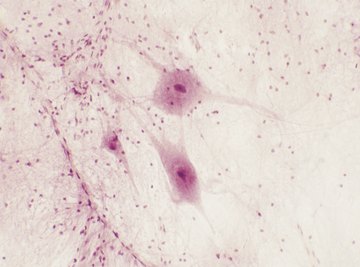
The cells of single-cell and multicell animals use extensions of their cytoplasm (the internal soup of the cell) to communicate with neighboring cells, for movement and for specialized processes like wound healing. Cytoplasmic extensions can vary in size and function depending on the type of cell they extend off of, and they can rapidly change their shape and length based on the different signals they receive and their environment.
Filopodia
Cells in your body can send out extensions from the cytoplasm like tentacles, called filopodia. They use these to help feel their way around as they move, gather nutrients and communicate with each other. When a new cell is made prior to birth in animals and humans, it can use cytoplasmic extensions like little antennae to send out signals to neighboring cells and received communications back. This helps the cell figure out what it's suppose to be: skin, cell, nerve or some other specialized cell.
Pseudopodia
Some small single-celled organisms such as amoeba use cytoplasmic extensions to crawl around to scavenge for food. These extensions are sometimes referred to as false feet; the more technical term for these false feet is pseudopodia. When an amoeba looks for and finds lunch, a bacterial cell for example, its pseudopodia wraps around the cell and engulfs it -- a process that's called phagocytosis. Once the bacterial cell is captured and taken in, it's broken down by enzymes and becomes food for the amoeba.
Dendrites and Axons
Nerve cells have two types of cytoplasmic extensions that are used for receiving signals from nearby cells and for passing information on to other cells. A nerve cell or neuron has a large cell body with small cytoplasmic extensions branching off from it called dendrites. The dendrites collect incoming information from neighboring cells. The collected messages move through the cell to a much larger cytoplasmic extension called the axon. The message travels down the axon and is passed along to another cell or group of cells that the axon branches out to touch. Your body uses nerve cells and their cytoplasmic extensions as a way to relay ongoing signals to and from your brain, muscles and other tissues.
Out of Control
Cytoplasmic extensions are not always a good thing. When a cell and its cytoplasmic extensions can no longer receive or give out the right signals, the cell can start to divide out of control and invade neighboring spaces. Some types of cancer cells with cytoplasmic extensions similar to filopodia can be dangerous and hard to remove or kill because the cytoplasmic extensions can invade and intertwine with healthy cells and tissue.
References
- Biology: The Unity and Diversity of Life, Tenth Edition; Cecie Starr and Ralph Taggart
- Washington University, Eric Chudler: Neuroscience for Kids
- National Cancer Institute: Metastatic Cancer
About the Author
Kris Heeter is a research scientist specializing in basic cancer and disease research. Her work has appeared in several scholarly journals and online publications. Heeter has also been a wellness professional for more than 15 years, teaching healthy cooking courses and fitness classes. She holds a Ph.D. in molecular and cellular biology.
Photo Credits
Comstock Images/Comstock/Getty Images
